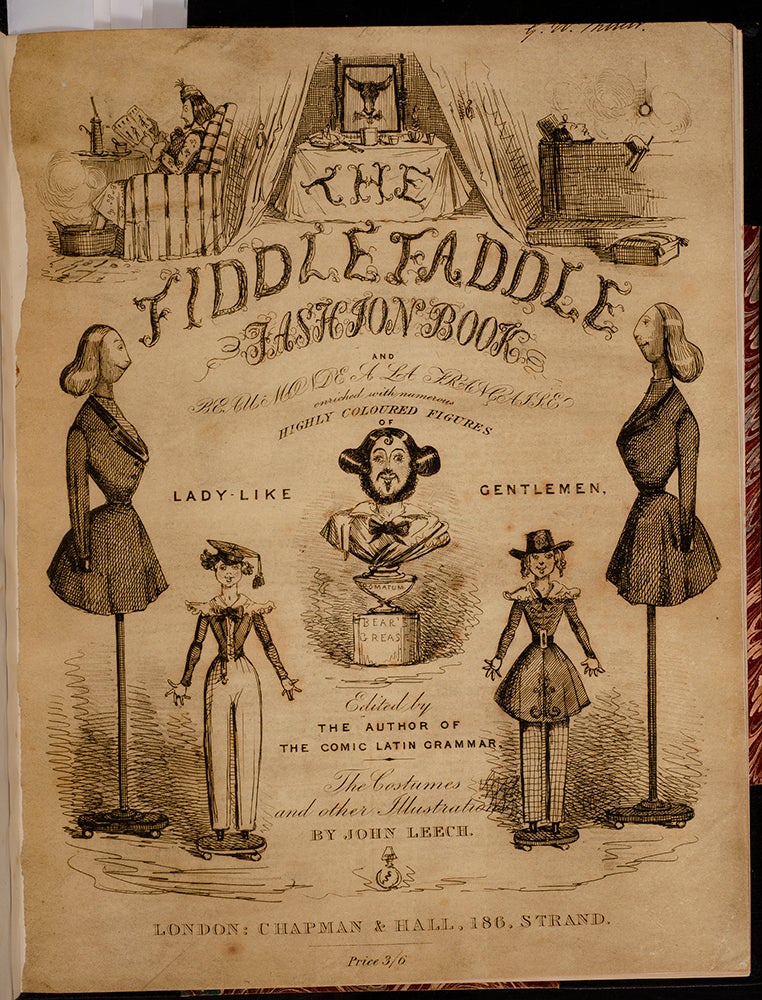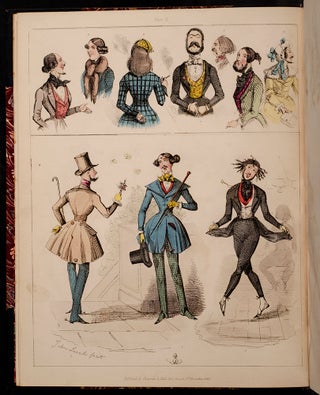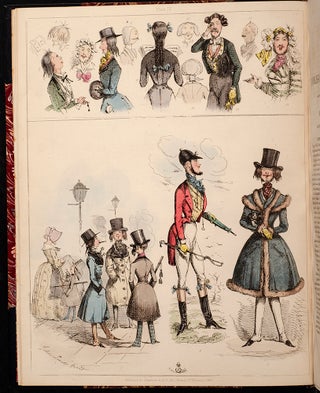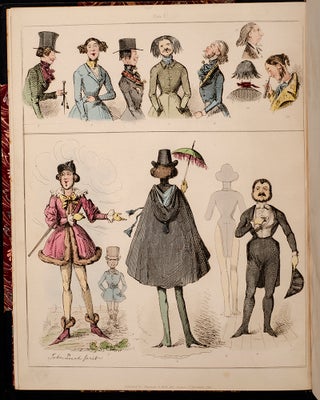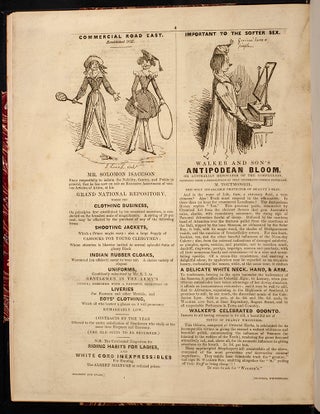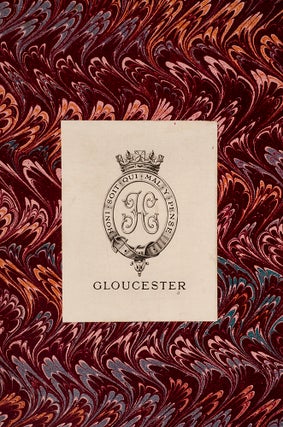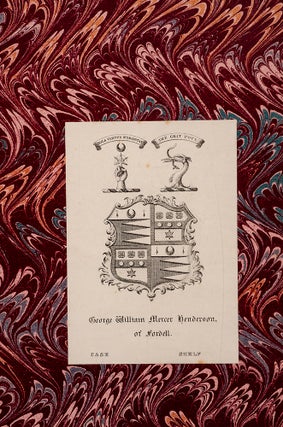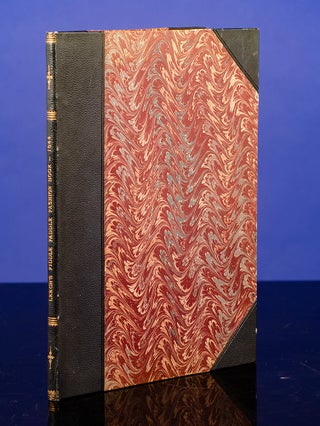Fiddle Faddle Fashion Book, The
London: Chapman and Hall, 1840. Item #04882
A Scarce Little Sucker
One of the Rarest of All Leeches
Victorian Unisex Costumes - Lady-Like Gentlemen
[LEECH, John, illustrator]. [LEIGH, Percival]. [The Fiddle Faddle Fashion Book. And Beau Monde à La Française enriched with Numerous Highly Colored Figures of Lady-Like Gentlemen. Edited by The Author of The Comic Latin Grammar.] The Costumes and Other Illustrations by John Leech. London: Chapman and Hall, 1840.
Large quarto (11 1/16 x 8 5/8 in; 282 x 219 mm.) 12 pp. Four hand-colored lithograph plates (imprinted 12 November 1840) each with multiple figures for a total of forty-six illustrations, from Leech's 1840 satire with text by Percival Leigh. Original pictorial front and back printed yellow wrappers bound in. Front wrapper with early ink signature at top (slightly cropped).
Contemporary half dark blue hard grain morocco ruled in blind over marbled boards. Smooth spine lettered in gilt, marbled endpapers, top edge gilt. With the armorial bookplates of George William Mercer Henderson on front paste-down and the Duke of Gloucester on front endleaf. Some foxing to endleaves not affecting any of the text or the colored plates. A fine copy.
One of the rarest of all suites by Leech, with OCLC noting only eight copies in institutional holdings worldwide.
"It was one of Leech's special delights to caricature the absurd fashions of the day in dress, language, manners and literature. These plates contain over fifty figures with text contributed by Percival Leigh" (Field).
"…The French fashion plates created the right spring-board for this satire; the French caricaturist Gavarni was a fashion illustrator for Le Journal des Gens du Monde, 1831, so that the humour and accuracy in costume caricature often went together. Leech was very quick to spot this and produced in 1840, a witty explosion of designs entitled The Fiddle Faddle Fashion Book and Beau Monde A La Francaise containing "numerous Highly-Coloured Figures of Lady-Like Gentlemen". The text was by his friend Leigh and the engraved plates showed a sort of unisex costume where dandies in ringlets and waisted coats actually appeared like women!… The early Victorian period was the scene for great beauty in female dress and male costume was neither as drab nor as dreary as is often supposed. Early on in his career… he produced The Fiddle-Faddle Fashion Book and the early lithographs pay great attention to both the dandy and the fashionable lady. Leech's acutely observant eye was always watching out for the over-fastidious, the superfinely frivolous, so that he could engage their foibles with his pencil. Fiddle-Faddle was done under the influence of [George] Cruikshank, and particularly under that side of Cruikshank that had created the Monstrosities plates of the late 'twenties. Leech's approach to fashion was therefore tinged with Regency satire but more liberally diluted with straightforward Victorian incredulity and disapproval! His attitude to caricaturing fashion can be seen very clearly if one looks closely at Leech himself as the fashionable man." Simon Houfe. John Leech and the Victorian Scene, pp. 39 & 139.
Artist and illustrator John Leech (1817-1864) provided the illustrations for Dickens’ A Christmas Carol, amongst other celebrated Victorian volumes, and was one of the first illustrators for the classic satirical journal, Punch. He established “a convention of social humour that was to last until the 1920s…Extravagantly praised by Ruskin, Leech’s often careless but never crude drawings have survived in charm and humour to give us a refreshing glimpse of mid-Victorian society” (Simon Houfe, The Dictionary of British Book Illustrators and Caricaturists 1800-1914).
Percival Leigh (1813–1889) "… comic writer, son of Leonard Leigh of St. Cross, Winchester, was born at Haddington on 3 Nov. 1818. He was educated for the medical profession at St. Bartholomew's Hospital, where he made acquaintance of his fellow-students, John Leech [q. v.], Albert Smith, and Mr. Gilbert à Beckett. He became L.S.A. in 1834, and M.R.C.S. in 1835, and resolved to practice his profession; but he soon abandoned medicine for literature. In 1841 he became a member of the 'Punch' staff very shortly after its formation, and he contributed to that journal until his death. Leigh was a good friend to Leech, whom he helped in many difficulties, and was also intimate with Thackeray. He was a good amateur actor, and with Dickens, Leech, and Jerrold was a member of the company which acted Ben Jonson's 'Every Man in his Humour' on 21 Sept. 1845, at Miss Kelly's Theatre, Dean Street, Soho (now the Royalty). Leigh played Oliver Cob. He never lost the interest in science which his early training had given him, and was jocularly known to his friends as 'The Professor.' Frith has noted his 'quaintly humorous conversation.' In 1850 Leigh lived at 10 Bedford Street, Bloomsbury, but before 1860 he had removed to Oak Cottage, Hammersmith, where he led a secluded life, and died on 24 Oct. 1889. He was the last survivor of the early writers in 'Punch.' His wife, Letitia Morrison, predeceased him." (Wikipedia).
Abbey, Life, 308; Field, p. 40.
Price: $3,500.00

 I have been in the rare and antiquarian book business for over forty years; my family has been in the rare books business since 1876. Rare books are in my blood.
I have been in the rare and antiquarian book business for over forty years; my family has been in the rare books business since 1876. Rare books are in my blood.
